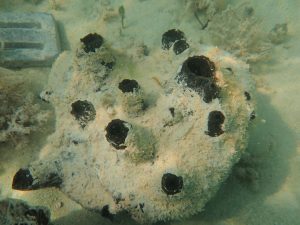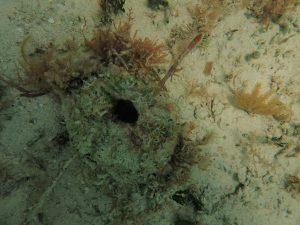Sponges Filter Water at Incredible Rates!

Sponges are animals that are incredibly important for improving water quality. Ounce for ounce, the amount of water they filter per day is astounding! A basketball-sized sheepswool sponge can filter over 500 gallons of water per hour, which is over 12,000 gallons per day! Since sponges do not have tissues or organs, all of this is happening at a microscopic level with tens of thousands of tiny flagella waving water in through thousands of tiny pores call ostia and out through the larger oscula. Sponges are found on both coasts of Florida, nearshore and at the reefs, where they are eating phytoplankton, bacteria, and viruses.
Sponges are Essential Fish Habitat for Many Animals!
They are essential fish habitat for juvenile spiny lobsters, stone crabs, and bonefish. These sponges are important places to hide from predators and provide a buffet of tasty invertebrate snacks. In the Florida Keys, these 3 species generate more than $150 million dollars to the economy from seafood, fishing, and tourism. There is also a commercial sponge fishery and Monroe County leads the state in the number of sponges landed. Unlike most commercially fished species, sponge landings are recorded by the piece and not by the pound. From 2020-2023 there was an annual average of 135,000 sponge pieces landed in Key West and Marathon. The average price per sponge piece was less than $2 with an estimated average annual value of $262,935. Sponges are also landed in these Florida counties: Pinellas, Pasco, Wakulla, Gulf, and very occasionally from Broward and Hillsborough counties. Nearly all harvested sponges are brought to Tarpon Springs for processing and sold around the world.
Bath Sponges were in Most Homes Before Invention of the Synthetic Sponge
The city of Key West has a very long history with sponges. Until the early 20th century, sponges were the second leading export from Key West, second only to hand-rolled cigars. Before Dupont created synthetic cellulose sponges in the 1940s, these wild harvested sponges were a household staple for bathing and cleaning. In fact, when most people think about sponges, they probably picture a bath sponge. Yet out of the nearly 9,000 sponge species, only a couple of dozen worldwide are the types suitable for harvest because they stay soft and spongy when processed and dried. In the Florida Keys, these are the species with the common names sheepswool, yellow, grass, mountain, hardhead, and basket sponges that inhabit the shallow nearshore waters associated with seagrasses and hardbottom.
Sponges Make Human Medicines, and More are Discovered Every Year!

Sponges are also incredibly important in the search for new human medicines. Since sponges cannot bite, pinch, or swim away, they have developed complex chemical defenses to ward off would-be predators. It turns out many of these chemicals have very potent anti-viral and anti-cancer properties. In fact, we have a very famous sponge located in just a few feet of water all over the Florida Keys! The scientific name is Tectitethya crypta, commonly called the Volcano Sponge because of the volcanic-shape and a single large, raised oscula usually covered in algae and sediments and it is very well camouflaged! In 1969 this was the first human medication from the ocean, and it was used to treat leukemia and now synthesized to make medications for herpes, HIV, and Ebola. Next time you snorkel or dive, take a moment to admire these magnificent animals!
 3
3
